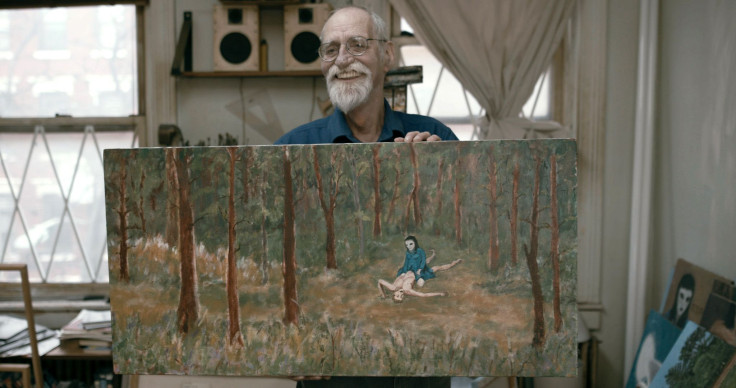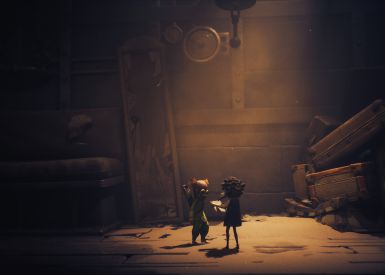The subject of the documentary Love and Saucers, David Huggins, announces the premise matter-of-factly: “Well, when I was 17 I lost my virginity to a female extraterrestrial.” His life story is fantastical, but there’s an additional wrinkle that transforms Love and Saucers from a familiar alien abduction testimonial into something altogether otherworldly, profoundly mysterious and beautiful: Huggins is a painter, who has spent decades interpreting his experiences on canvas.
Huggins was eight, a young boy in 1950s Georgia, when he had his first encounter. “There was this little hairy guy with large, glowing eyes coming straight toward me. I thought it was the boogeyman, I didn’t know what to think of it. What was interesting was that for a split-second I felt as if I was in his eyes, looking at me. Then I just freaked.”
The encounters escalated quickly. After the hairy guys, the next visitor was a “giant, insect-like being,” resembling a praying mantis. Huggins first encounter with the mantid was terrifying, especially when the giant, spindly thing began spraying a bluish-gray liquid, but Huggins soon found a surprising empathy in the alien being. “He always spoke to me as if I was a child.”

Then came the greys, whole squads of them, dropping from the sky in blue tunics. They followed him home. “I looked underneath our house, because it was on pillars, and I could see their legs on the other side,” Huggins recounts in the movie. They returned that night and abducted him for the first time. Inside their craft he met Crescent, the alien woman who would take his virginity several years later. Their first meeting was less pleasant: Crescent inserted an object far up David’s nose. “You know how we tag whales and stuff like that?”
Sometime after Crescent first had sex with Huggins, he moved to New York, away from Georgia and his abusive, alcoholic parents. There, the relationship continued for years, with Crescent emerging from a portal in his wall at night. Other creatures often observed their sex. Sometimes, Huggins was taken into space, where he met the children produced by his couplings with Crescent.
Huggins’ experiences are extravagantly unbelievable, nevertheless it’s impossible to watch Love and Saucers and truly disbelieve. This is not because Love and Saucers upends your entire conception of the universe or our place in it; or makes the case for sustained extraterrestrial interference in Earthly affairs. Instead, it’s because of Huggins himself: earnest, straightforward and unwilling to evangelize or project beyond the exact parameters of his memories. Whether alien, other-dimensional, supernatural or psychological, Huggins presents the remarkable events that have shaped his life with a straightforward honesty and humility that draws us in, maybe not to an alien realm, but to the absolute certainty that the fantastical has been touched.
Love and Saucers’ greatest strength as a documentary is the dignity it affords Huggins’ experiences. There is no cutting away to lurid UFO photos or testimonials from History Channel kooks. There’s just one man’s life, the story he tells and the canvasses on which he processes unearthed memories of abduction, communion and sexual awakening.
Love and Saucers director Brad Abrahams spoke with Player.One about how he captured and dignified Huggins’ life and work, without falling into the typical UFO documentary tropes. “Love and Saucers is much less about aliens and alien abductions — it’s about the person.”

Abrahams filmed Love and Saucers over a three-year period, conducting interviews a few days at a time, occasionally staying with Huggins in his Hoboken, New Jersey home. “What strikes me so much: David is just such a seemingly normal, simple spoken, straight talking kind of guy,” Abrahams told Player.One.
Only one outside expert is consulted in Love and Saucers: Dr. Jeffrey J. Kripal, in the Department of Philosophy and Religious Thought at Rice University, whose research considers the overlap between religious epiphany and sex. “I wanted someone who was skeptical but not cynical,” Abrahams said.
But why a religious perspective? “[Kripal] doesn’t see alien abductions as any different from someone in the 15th century having a Christian religious experience or in the Greek times having a deity experience. These are all the same things happening to us,” Abrahams explained.
Kripal’s appearance comes late in the documentary, but he makes explicit one of Love and Saucers ’ great strengths. Rather than treating Huggins as a question — “Did this happen?” — it dignifies human experience, no matter how extraordinary.
Which is not to say that Love and Saucers avoids the question of how closely Huggins’ experiences may hew to objective reality, whatever that means. The pieces are there for any determined skeptic to concoct a plausible psychological out: abusive parents and Budd Hopkins’ landmark alien abduction book, Intruders: The Incredible Visitations at Copley Woods, which hit Huggins like a thunderclap, returning some of his repressed memories when he read it in 1987.
“It’s very complex, I don’t have a straight answer. I think it’s clear in the film that I believe that David is telling the truth about what he experienced, but not necessarily that I believe that what happened to him happened literally,” Abrahams said. “He’s having these memories of something that happened to him, but maybe he couldn’t articulate it and we have a tendency to pull from the world around us.”
Abrahams brought up a possible connection between Huggins’ abduction accounts and his immense VHS collection, nearly 2,000 tapes, many sci-fi and horror (Huggins’ makes several excellent recommendations, including ghost story classic The Uninvited and 1973’s squamata body horror, Sssssss). “It’s a chicken and egg, did he collect those VHSs because of those encounters, or did he pull from those VHS tapes?”
“There’s definitely an impressionability in everyone,” Abrahams said. “David experienced something, but the context of what happened is colored, just by being human.”
And it’s that human need to understand, to process those experiences that confuse and tantalize us, that motivates Huggins’ paintings as much as the viewer’s interest.
Love and Saucers is now available for VOD streaming on iTunes, Amazon, Vimeo, Google Play and YouTube.


















